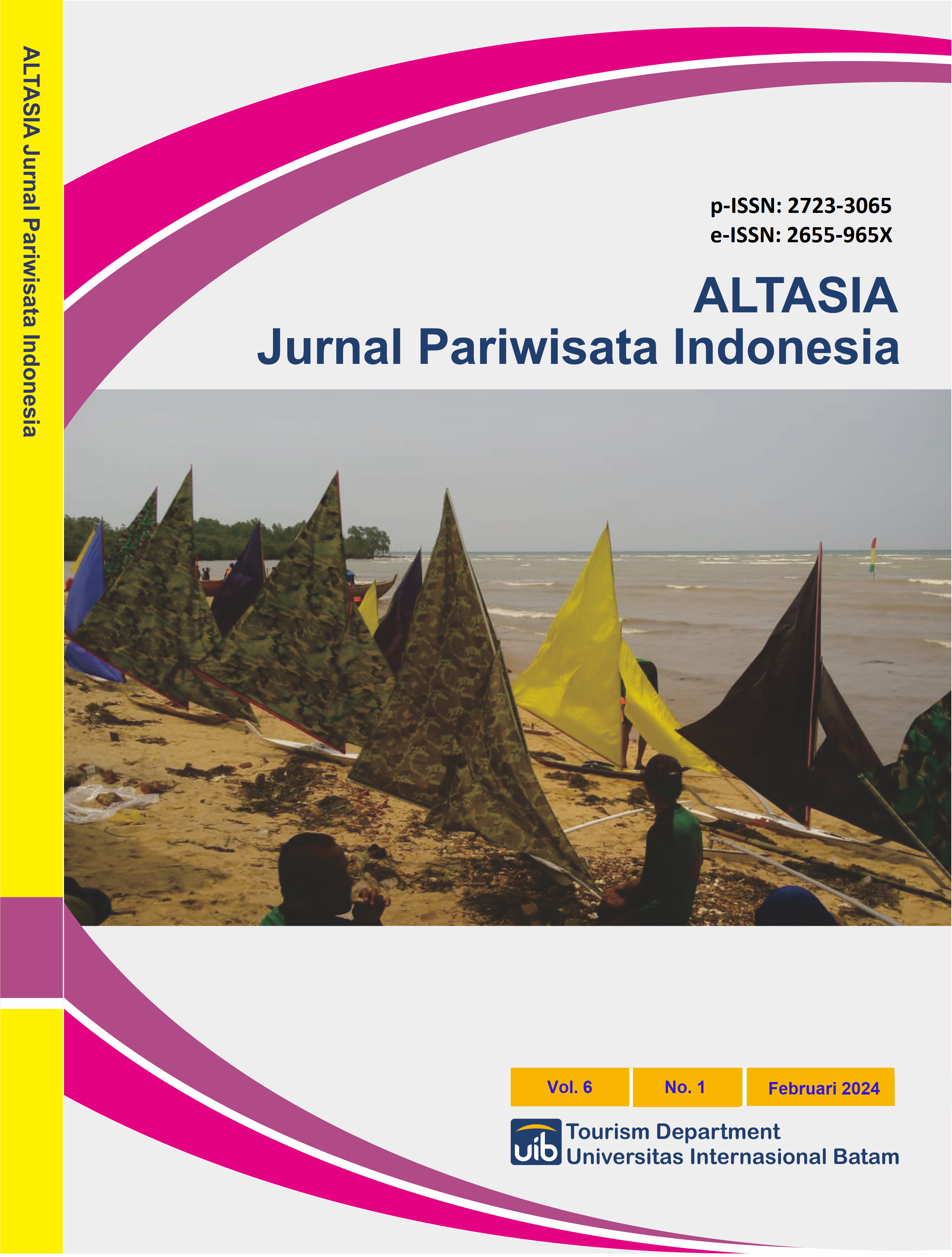Perancangan Strategi Bisnis Pariwisata Berkelanjutan di Jawa Barat dengan Analisis Internal dan Ekternal serta Triple Layer Business Model Canvas
DOI:
https://doi.org/10.37253/altasia.v6i1.8658Keywords:
internal and external analysis, Triple Layer Business Model Canvas, sustainable tourism, natural tourismAbstract
The impact of Covid-19 on the growth of the tourism sector is considered to be hampered by several factors. To overcome this challenge, there are several things that can be done, for example developing quality and innovative tourism destinations. Another thing that can be done is utilizing the role of technology and infrastructure. The sustainable tourism trend is believed to be a tourism trend in Indonesia in the future. This research was conducted in West Java as the province with the most destinations in Indonesia. This research formulates a sustainable tourism business strategy by analyzing internal and external factors, as well as the Triple Layer Business Model Canvas. The object studied was the Ir. Forest Park. H. Djuanda (Tahura Djuanda) who is in Bandung City. The results of this research are that the Tahura Djuanda tourist attraction is able to use its strengths and deal with internal weaknesses. Then Tahura Djuanda was also able to take advantage of external opportunities and threats. The results of the TLBMC analysis of economic aspects can be used by Tahura Djuanda to strengthen the value proposition offered. TLBMC environmental aspects can be developed by Tahura Djuanda through the development of functional values. Furthermore, the TLBMC results from Tahura Djuanda's social aspects can optimize her role in social culture.
Downloads
References
Amirshenava, S., & Osanloo, M. (2022). Strategic planning of post-mining land uses: A semi-quantitative approach based on the SWOT analysis and IE matrix. Resources Policy, 76 (June 2021). https://doi.org/10.1016/j.resourpol.2022.102585
Badan Pusat Statistik (2018). Jumlah Daya Tarik Wisata 2018. https://jabar.bps.go.id/indicator/16/397/1/jumlah-daya-tarik-wisata.html
Badan Pusat Statistik (2021). Luas Daerah dan Jumlah Pulau Menurut Provinis, 2021. https://www.bps.go.id/indikator/indikator/view_data_pub/0000/api_pub/UFpWMmJZOVZlZTJnc1pXaHhDV1hPQT09/da_01/1
Ferro, C., Høgevold, N., & Padin, C. (2018). Framing the triple bottom line approach: Direct and mediation effects between economic , social and environmental elements. 197,
Hayati, M., Mahdevari, S., & Barani, K. (2023). An improved MADM-based SWOT analysis for strategic planning in dimension stones industry. Resources Policy, 80(June 2022). https://doi.org/10.1016/j.resourpol.2022.103287
Jabar Open Dara (2023). Jumlah Pendapatan Asli Daerah Bidang Pariwisata Berdasarkan Sektor Wisata di Jawa Barat. https://opendata.jabarprov.go.id/id/dataset/jumlah-pendapatan-asli-daerah-bidang-pariwisata-berdasarkan-sektor-wisata-di-jawa-barat
Joyce, A., & Paquin, R. L. (2016). The triple layered business model canvas: A tool to design more sustainable business models. Journal of Cleaner Production, 135, 14741486. https://doi.org/10.1016/j.jclepro.2016.06.067
Kemetrian Pariwisata dan Eknomi Kreatif (2023). Outlook Pariwisata dan Ekonomi Kreatif.
Kemetrian Pariwisata dan Eknomi Kreatif (2023). Expert Survey: Sektor Pariwisata dan Ekonomi Kreatif Tumbuh pada 2024. https://kemenparekraf.go.id/ragam-pariwisata/expert-survey-sektor-pariwisata-dan-ekonomi-kreatif-tumbuh-pada-2024
Leigh, D. (2010). SWOT Analysis Chapter Five. Handbook of Improving Performance in the Workplace, 2, 115-139.
Mallard, K., Garbuio, L., & Debusschere, V. (2020). Towards sustainable business model and sustainable design of a hydro generator system dedicated to isolated communities. Procedia CIRP, 90(March), 251-255. https://doi.org/10.1016/j.procir.2020.02.004
Osterwalder, A., & Pigneur, Y. (2010). Business model generation: a handbook for visionaries, game changers, and challengers (Vol. 1). John Wiley & Sons.
Pollard, J., Osmani, M., Grubnic, S., Daz, A. I., Grobe, K., Kaba, A., & Panchal, R. (2023). Implementing a circular economy business model canvas in the electrical and electronic manufacturing sector: A case study approach. Sustainable Production and Consumption, 36, 1731. https://doi.org/10.1016/j.spc.2022.12.009
Teoli D, An J. 2019. SWOT Analysis. NCBI Internet Bookshelf. Treasure Island, FL: StatPearls Publishing. URL: https://www.ncbi.nlm.nih.gov/pubmed/30725987 [accessed 18 November 2023].
Zhang, H., & Chen, M. (2013). Research on the recycling industry development model for typical exterior plastic components of end-of-life passenger vehicle based on the SWOT method. Waste Management, 33(11), 2341-2353. https://doi.org/10.1016/j.wasman.2013.07.004
Downloads
Published
Issue
Section
License
Copyright (c) 2024 Altasia Jurnal Pariwisata Indonesia

This work is licensed under a Creative Commons Attribution-NonCommercial 4.0 International License.
The article publication is wholly owned by the Indonesian Tourism Journal (ALTASIA).






.png)





